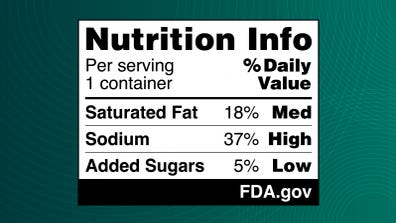- Food manufacturers must meet new criteria to put “healthy” on a food product.
- The new rule goes into effect Feb. 25, 2025, with a compliance date in 2028.
- A new label on the front of food packages is being proposed to help consumers easily see saturated fat, sodium and added sugars.
Trying to eat healthy? Having a tough time reading those food labels? And what constitutes healthy, and can you believe what manufacturers say on a package?
The U.S. Food and Drug Administration is trying to help.
In December, it issued a new rule on what packages can use the word “healthy.”
The agency also is considering a smaller food nutrition label to go on the front of packages.
Here’s what you should know.
FDA issues new rule on what can get ‘healthy’ claim on food package
In December, the FDA issued a final rule to update the “definition for the implied nutrient content claim ‘healthy’” on food packages, according to the Federal Register.
The new rule will “help consumers identify foods that can serve as the foundation of a nutritious diet that is consistent with current dietary recommendations.
“Consumers rely on food labels when navigating the marketplace to make informed choices about the foods they purchase for themselves and their families. FDA plays an important role in ensuring that the labels or labeling of food for human consumption, including claims on labels or labeling that market a food, are accurate, truthful, and not misleading,” the Federal Register said.
What does a food package have to have to be labeled as healthy?

To meet the new criteria for the claim of healthy, a food product needs to:
- Contain a certain amount of food from at least one of the food groups or subgroups — such as fruit, vegetables, grains, fat-free and low-fat dairy and protein foods — recommended by the Dietary Guidelines for Americans, and
- Meet specific limits for added sugars, saturated fat and sodium.
➤ See the latest dietary guidelines
“Under the updated ‘healthy’ claim, nutrient-dense foods that are encouraged by the Dietary Guidelines — vegetables, fruits, whole grains, fat-free and low-fat dairy, lean game meat, seafood, eggs, beans, peas, lentils, nuts, and seeds — with no added ingredients except for water, automatically qualify for the healthy claim,” the FDA said.
When do the new ‘healthy’ food label claims go into effect?
The new rule is effective Feb. 25, 2025.
The compliance date of is Feb. 25, 2028, according to the Federal Register.
FDA proposing at-a-glance food labels on front of packages

The FDA announced in January it was proposing at-a-glance nutrition information on the front of packaged foods.
“If finalized, the proposal would give consumers readily visible information about a food’s saturated fat, sodium and added sugars content — three nutrients directly linked with chronic diseases when consumed in excess,” the FDA said.
What is the benefit of new front-of-package food labels?
The proposed nutrition label, also called the Nutrition Info box, would provide information on saturated fat, sodium and added sugars content in a simple format, the FDA said.
The label would show whether the food has low, medium or high levels of those nutrients.
“The science on saturated fat, sodium and added sugars is clear,” said Dr. Robert M. Califf, FDA commissioner.
“Nearly everyone knows or cares for someone with a chronic disease that is due, in part, to the food we eat. It is time we make it easier for consumers to glance, grab and go. Adding front-of-package nutrition labeling to most packaged foods would do that.”
What chronic diseases are attributed to excessive fat, sodium and sugar?
“Chronic diseases — including heart disease, cancer and diabetes — are the leading cause of disability and death in the U.S.,” the FDA said.
“A large body of research indicates that a major contributor to this problem is excess consumption of saturated fat, sodium and added sugars. There is a proliferation of foods in the food supply that are considered ultra processed, which often contain high levels of these nutrients.
“The Nutrition Info box is focused on providing accessible information to help consumers quickly and easily identify how foods can be part of a healthy diet.”
What is the leading causes of death in Florida?
According to the Florida Department of Health, in 2023 — the latest year data is available — the leading causes of death in the state were:
- Heart disease: 48,961 (21.38% of all deaths)
- Cancer: 47,088 (20.56% of all deaths)
- Stroke: 16,485 (7.20 % of all deaths)
- Unintentional injury: 16,435 (7.18% of all deaths)
- Chronic lower respiratory disease: 11,214 (4.90% of all deaths)
- Diabetes: 7,288 (3.18% of all deaths)
- Alzheimer’s disease: 5,974 (2.61% of all deaths)
- COVID-19: 3,645 (1.59% of all deaths)
- Suicide: 3,558 (1.55% of all deaths)
- Chronic liver disease and cirrhosis: 3,529 (1.54% of all deaths)
Would the new nutrition info box replace the side label?
No. The small label on the front of the box would complement the side label, provides more detailed information.
When would the new nutrition labels appear on food we buy?
The proposed rule, if finalized, would require food manufacturers to add a nutrition info box to most packaged food products three years after the final rule’s effective date for businesses with $10 million or more in annual food sales and four years after the final rule’s effective date for businesses with less than $10 million in annual food sales, the FDA said.
Send your comments about proposed nutrition info box
Comments on the proposed rule can be send to regulations.gov by May 16.
